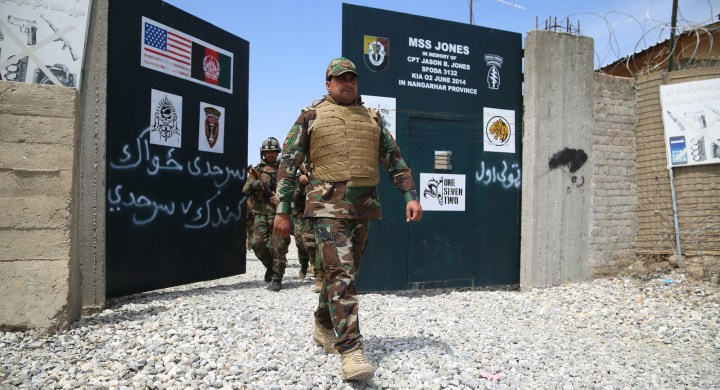TWENTY YEARS AFTER 9/11
The Great Game continues: Joe Biden’s big gamble in Afghanistan

After two decades, the US now says it will leave Afghanistan and say a little prayer that the Taliban and their friends Al-Qaeda don’t make a dramatic, bloody comeback. It is a gamble, that’s for sure.
When you’re wounded and left on Afghanistan’s plains, and the women come out to cut up what remains, jest roll to your rifle and blow out your brains and go to your gawd like a soldier.
From Rudyard Kipling’s Soldiers of the Queen
On 11 September 2001, one iteration of the post-Cold War world melted away, only to be replaced by another. This second version now has an end date as well. And it will be coming exactly 20 years after that earlier one.
Back when the Soviet Union collapsed, its Eastern European empire disintegrated, and its political-economic structures evaporated as any kind of model for the future, these three came so quickly they virtually seemed foreordained.
In the aftermath, an increasingly triumphalist rhetoric took hold, led by writers like Francis Fukuyama who argued the world had crossed its Rubicon and an age of non-ideological confrontation was upon us, with the growing strength of a near-universal version of liberal democratic, social welfare capitalism. This blended nicely with the kinds of politicians who were coming to the fore in Western nations — and, increasingly, in others beyond the traditional democratic sphere.
Well, okay, this grand analysis left out a number of things: the variety of political and economic conflicts at the margins, the ongoing technological revolutions from IT and other advances, and the increasingly visible effects of climate change. Moreover, this vision also largely ignored a real recognition of the influence and impact of ideological disagreements, the rise of identitarianism globally, and social movements that drew on religious fervour and married that to political agendas — such as the emerging populist energies of the political religious right in the West or Islamic fundamentalism elsewhere.
As we all now know, fewer than two dozen young men, imbued with an end-of-days, eschatological Wahhabism, and recruited largely from among Saudi Arabian students who came to the US to study aeronautics and flying (but not takeoffs or landings, apparently), hijacked four commercial airliners. Having overcome their pilots, the hijackers crashed the planes into the twin towers of New York City’s World Trade Center and the Pentagon, with (presumably) one headed to the White House or Capitol building as well, thereby causing death and destruction on an epic scale. One of the casualties was the triumphal, end-of-history rhetoric that had been much about until that morning.
Enraged by these acts, the new presidency of George W Bush sought to identify the culprits and their leader, their base of operations, and their larger plans. The US, quickly enough, determined it was the still little spoken-about group Al-Qaeda, led by Osama bin Laden, the renegade scion of a rich construction firm-owning family, who had been keeping his powder dry deep in the mountains of Afghanistan, under the watchful protection of the Taliban that was now effectively in control of the country. The Taliban had evolved out of the rebel groups that were eventually supplied Stinger missiles by the US to help defeat the Soviet army then effectively controlling Afghanistan.
The United States, seized nationally with a need to avenge the death and destruction in its political and financial capitals, inexorably moved from dealing directly with those who had caused such things — and on to the broader mission of ridding Afghanistan of the Taliban scourge, ultimately driving them out of the capital and other major cities — and back into isolated mountain hideaways.
This was the group which had been, after all, bent on driving that unfortunate country back into a medieval world where women would be totally cloistered away, where education would be strictly rationed and restricted, where a particularly strident brand of religious law would now reign supreme, and the rather feckless civilian government in the country that had taken over after the Russians driven out.
As if by magic, though, the US mission continued morphing into larger, broader, grander versions. It became one of nation-building and the imposition of Western democratic values, almost regardless of the desires of the inhabitants.
The mission was passed from president to president — from George W Bush to Barack Obama, and from the latter to Donald Trump, and now to the newly elected Joe Biden. Throughout these two decades, the number of US troops rose and then fell, at one point reaching around 100,000 personnel, along with contributions from the country’s Nato allies, all fighting the Taliban and trying to train, equip, and motivate a new Afghan government and its military and police forces.
At one point, when it seemed entirely possible the Afghan government would lose completely to the Taliban (a circumstance that had eerie echoes for many of the US efforts in Vietnam in the late 1960s), President Obama authorised what was called “the surge” in troop numbers and mission. This effort, it has now been well-reported, was opposed by the then vice-president, Biden, although he kept his counsel and opposition to the generals out of the public limelight at the time.
On US forces’ activities in Afghanistan (and nearby Iraq), the previous administration had positioned itself strongly as intent on ending the “forever wars” the US population had grown weary of, for lack of an endpoint or easily discernible goal. And in 2020, Trump announced (before they reversed themselves) that the deployments would end on 1 May — even before the generals had been informed of this decision.
The new administration has accepted this general position as a policy goal and, after full deliberations, has itself now announced the residual US deployment of some 2,400 personnel carrying out training and air support will come to a definitive end on the 20th anniversary of 9/11.
As The Washington Post said on 19 April, “Three months after taking office, President Biden has reestablished the formal decision process, which his predecessor seemed determined to destroy, that has guided U.S. administrations through foreign policymaking since the Second World War.
“Afghanistan was among the first major issues on which the process, organized and directed by the National Security Council, became fully operational. Dozens of high-level meetings were held, including four separate sessions with the president in the Situation Room. Military, intelligence and diplomatic assessments were compiled, and consultations were held with allies and lawmakers.
“Yet at the end of the day, Biden did not budge from where he began nearly 13 years ago, when a visit to Afghanistan as vice president-elect convinced him, he said last week, that ‘more and endless American military force could not create or sustain a durable Afghan government.’ ”
Meanwhile, in a Nato meeting, in which the US secretaries of state and defence informed the alliance of the decision, Secretary-General Jens Stoltenberg indicated other alliance members with troops in Afghanistan had little choice but to follow suit. As he said afterwards, “In light of the US decision, all Allies agreed to the statement.”
What will this mean in concrete terms — as well as symbolic and strategic ones? In combat terms, no American has perished for months on end, and so the human cost — for Americans, at least, albeit not Afghans — has become lower than the annual death toll from regular training exercises.
There are virtually no popular protests in the US about military personnel deployed to Afghanistan, and barely a mention in the media of the activities of those who are still there. But there is a sense by this administration that a deployment in Afghanistan has been a diversion from more important international issues, such as the increasingly fraught US-Russia, US-China, and US-Iran relationships, as well as all those pressing domestic questions. And, of course, there remains the Covid-19 pandemic and the resulting economic slump that are still “Job One”.
Still, there are voices among policy scholars, some media, and within the Republican caucus in Congress that have opposed Biden’s definite departure deadline for a variety of reasons. For example, The Economist, a leading voice for principled internationalist leadership by the US, has come out as opposed to this decision.
As it wrote on 17 April in its lead editorial, “The Taliban are as strong as they have been since 2001. The Afghan state, backed by America and its Nato allies, is tottering. This time, however, Mr Biden is in a position to get his way. By September 11th, two decades exactly since al-Qaeda terrorists felled the twin towers, prompting America to overthrow the Taliban regime that harboured them, almost all the remaining 2,500 American troops in Afghanistan will have left. A handful will stay to guard the embassy. The decision was made against the advice of America’s generals, who had warned Mr Biden (and Donald Trump before him) not to pull out.
“Mr Biden thinks the costs of staying outweigh those of leaving. He campaigned promising to end America’s ‘forever wars’. Few Americans see the case for remaining part of a seemingly unwinnable conflict 7,000 miles away. Yet the decision was wrong. American troop levels were already much reduced. No American soldier has died in combat in over a year. It costs little to keep a small force in place, guaranteeing the security of a larger number of Nato troops who have been training Afghan forces. With America gone, they will surely leave, too.
“America has defended other allies, such as South Korea, for far longer than it has protected the Afghan government. Abandoning Kabul to its fate will undermine other allies’ confidence in America. And it will lead to more bloodshed, not less. Civilian casualties are already mounting; the number killed increased by 29% in the first three months of this year, compared with last, says the UN. The government still controls most cities, but several, including Kabul, are under siege and racked by suicide bombings. The Taliban hope to oust the government, just as they ousted and slaughtered Afghanistan’s rulers in the 1990s after their Soviet sponsor collapsed. A Taliban victory could mean the reimposition of a pious, premodern tyranny. Urban Afghans could lose the freedom to listen to pop music. Girls may be stopped from going to school, or killed if they try.”
The Economist, making the case for a continuing, limited engagement, then argued the Taliban “…must be made to realise that if they take over by force, they will be international pariahs once again, and the money [from outside sources and support for their offices while they are theoretically engaged in negotiations] will stop. Even in Taliban-held districts, teachers and doctors are paid by foreign donors. Ashraf Ghani, Afghanistan’s president, must also now realise that more American troops are not coming to his rescue, and try seriously to negotiate — or cede his position to someone who will.”
Eventually, if the Taliban enters into or becomes the government, the more likely it is that modern social protections of the new regime will be dispensed with, and it will be goodbye to participation in public life and education for women, at a minimum. If the old theocratic obscurantists are back in charge, and if they take up with Al-Qaeda yet again, the Americans may feel the need to come back all over again, only this time into a geopolitical landscape that is less favourable than before — and with less military sinew for them to flex.
But beyond the circumstances within Afghanistan, the collapse of the current government there will have larger effects internationally. For one thing, the argument goes, it may provide proof the Americans are never in something for the really long run, thereby emboldening other groups pushing against unstable or febrile regimes elsewhere. While this is not quite the return of the old domino theory — a defeat in Vietnam would inevitably lead to a Chinese communist victory throughout East and Southeast Asia — a wired, online world does mean groups far distant from one another can take succour from the success of any one of them, and learn from others’ successes.
Such an outcome may also lend credence to the siren song of China that this is yet one more example of a United States, now past its prime, no longer able to stick things out. That lesson, too, would be noted among US allies and foes alike. Such a result would be especially closely studied in New Delhi and Islamabad, as well as Tehran, and would motivate different responses to the changing environment — changes that at this point are unpredictable but probably contributing towards more instability in the greater South Asian region rather than less.
And, of course, there is the domestic political risk for Biden. The US has a midterm election in 2022, and then, two years thereafter, the next presidential general election. While it would be unlikely for a groundswell of enthusiasm for a renewed engagement in Afghanistan, the realisation — if it comes to that — that things were pretty much back to where they were in 2001, with a Taliban government in charge and Al-Qaeda on the loose, is certain to give support to misgivings among voters and be an easy card for Republicans to use somehow.
They could well argue the Biden administration is simply not competent. While this would not be the same as the chant that “Who lost China?” was for the GOP throughout the 1950s, it would certainly complicate any Biden re-election bid, or of a push for the vice-president to take up the cudgels for the Democrats, in the event Biden chooses not to run again.
Ultimately, for Americans, however, the complete departure from Afghanistan by the US (and thus any Nato contingents as well) will bring a reckoning among active-duty military, reservists, and now-discharged veterans to question whether their sacrifices, and the deaths and injuries of their comrades, were really worth it.
The sight of retaliation against or revenge killings of those who fought with or worked with the US and allies on the evening news or streamed online would be very troubling to viewers — and could well have real political consequences. This decision by Biden is a bold one, but it is also a big gamble, and the odds may not be in his favour. DM




















It seems pretty clear that the Taliban are the popular choice for the people of Afghanistan and only a never-ending occupation by foreign forces will keep them from power. The US never stood a chance of winning this war, no more than any other invader of Afghanistan before them.